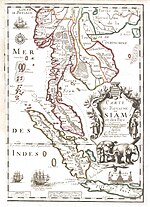

Wen Dan
(文單) | |
|---|---|
| 7th century–8th century | |
| Capital | Kantharawichai[1] |
| Religion | Buddhism |
| Historical era | 7th-8th century |
• Established | 7th century |
• Disestablished | 8th century |
Part of a series on the
|
||||||||||||||||||||||||||||||||||||||||||||||||||||
|---|---|---|---|---|---|---|---|---|---|---|---|---|---|---|---|---|---|---|---|---|---|---|---|---|---|---|---|---|---|---|---|---|---|---|---|---|---|---|---|---|---|---|---|---|---|---|---|---|---|---|---|---|
| History of Thailand | ||||||||||||||||||||||||||||||||||||||||||||||||||||
 | ||||||||||||||||||||||||||||||||||||||||||||||||||||
|
Timeline
|
||||||||||||||||||||||||||||||||||||||||||||||||||||
|
Topics |
||||||||||||||||||||||||||||||||||||||||||||||||||||
|
| ||||||||||||||||||||||||||||||||||||||||||||||||||||
|
|
Wén Dān (Chinese: 文單; Thai: เหวินตัน) was a group of ancient Mon political entities that existed around the 7th–8th centuries CE in the interior of mainland Southeast Asia scattered around the central Mekong Valley in the present-day northeast Thailand.[1][2][3] It was mentioned in the Chinese annals of the Tang period (618-907 AD) as a dependency on the trans-Mekong trade route from the ancient city of Chiaochih (jiāo zhǐ 交趾; Giao chỉ; near the present-day Vinh of Vietnam) to India.[1]: 25–72 Wen Dan sent representatives to China in 656 – 661, 717, 753, 771, and 798.[1][4]
Initially, Wen Dan was believed to be either Vientiane,[1][2] or the capital of the Land Chenla (Po-Lou),[5]: 16 but according to the location given in the annals as well as archaeological evidence, it is supposed to be in Chi River basin,[1][2] centered in Kantharawichai, with Mueang Fa Daet Song Yang as outer center and Champasri (จัมปาศรี; in present Na Dun district) as the vassal.[1] Several historical evidences supports the connection between Wen Dan and Si Thep in central Thailand.[4]: 91–92
According to the Dvaravati Buddhist boundary stones (Bai sema) dated the 8th century found on Mt. Kulen, Woodward (2003) proposes that Wen Dan once controlled the Angkor region before Jayavarman II proclaimed the independence of the Kambujadesa from Java in 802.[4]: 87–88 Jayavarman II probably either defeated Wen Dan and then moved the capital from IndrapuratoYaśodharapura in the north,[4]: 87 or formed ally with the communities in Mun and Chi watersheds to against Si Thep in the west.[4]: 93
After the Tang dynasty was defeated by Nanzhao in the trade routes conflicts in 753 and 755, the King of Wen Dan sent his son and 26 generals to China to help the fight.[1][3]
In 766, a Tang army of 70,000, led by General Li Mi from Sichuan, invaded Nanzhao. Vietnamese Governor "He Lu Guang" joined Wen Tan in attacking the south, but Ko-lo-Feng, the Nanzhao king, captured General Li and won. Wendan's army returned home. In 771, the prince of Wen Dan went to China and was titled "Special Highest Local Commander," equal to the King of Nanzhao, and was even higher than the Chinese governors in Vietnam and Guangzhou.[1][3]
This section is empty. You can help by adding to it. (April 2024)
|
|
| |||||||||||
|---|---|---|---|---|---|---|---|---|---|---|---|
| Antiquity |
| ||||||||||
| History |
| ||||||||||
| Initial states |
| ||||||||||
| Regional kingdoms |
| ||||||||||
| Regional history |
| ||||||||||
| Topical history |
| ||||||||||